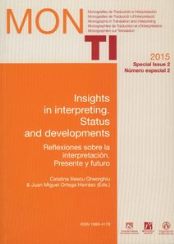The influence of healthcare professionals on medical interpreting recognition and development
##plugins.themes.bootstrap3.article.main##
Resum
Descàrregues
##plugins.themes.bootstrap3.article.details##
La propietat intel·lectual dels articles pertany als autors i els drets d'edició i publicació, a la revista. Els articles publicats en la revista podran ser utilitzats lliurement per a propòsits educatius i científics, sempre que se'n faça una correcta citació. Qualsevol ús comercial és expressament penat per la llei.
Referències
Angelelli, Claudia V. (2007) “Assessing Medical Interpreters: The Language and Interpreting Testing Project.” The Translator 13:1, pp. 63-82.
Angelelli, Claudia V. (2008) “The role of the interpreter in the healthcare setting. A plea for a dialogue between research and practice.” En: ValeroGarcés, Carmen & Anne Martin (eds.) 2008. Crossing Borders in Community Interpreting. Definitions and Dilemmas. Amsterdam & Filadelfia: John Benjamins, pp. 147-163.
Bischoff, Alexander & Patricia Hudelson. (2010a) “Access to Healthcare Interpreter Services: Where Are We and Where Do We Need to Go?” International Journal of Environmental Research and Public Health 7, pp. 2838-2844. Electronic version: http://www.ncbi.nlm.nih.gov/pmc/articles/PMC2922730/
Bischoff, Alexander & Patricia Hudelson. (2010b) “Communicating With Foreign Language–Speaking Patients: Is Access to Professional Interpreters Enough?” Journal of Travel Medicine 17:1, pp. 15-20. Electronic version: http://onlinelibrary.wiley.com/doi/10.1111/j.1708-8305.2009.00314.x/pdf
Bischoff, Alexander; Louis Loutan & Sofía García. (2009) En otras palabras. Guía para la consulta médica intercultural. Comunicación a través de un intérprete en los servicios de salud. Electronic version: http://www.universaldoctor.com/EnOtrasPalabras/
Brisett, Camille; Yvan Leanza & Karine Laforest. (2013) “Working with interpreters in health care: A systematic review and meta-ethnography of qualitative studies.” Patient Education and Counseling 91:2, pp. 131-140.
Corsellis, Ann. (2009) Public Service Interpreting: The First Steps. Basingstoke: Palgrave MacMillan. Citado por la traducción española de Carmen ValeroGarcés & Rosa Cobas: Traducción e interpretación en los servicios públicos. Primeros pasos. Granada: Comares, 2010.
Del Pozo, María Isabel. (2009) “Una propuesta formativa en interpretación en los servicios públicos en el marco del EEES.” Redit 3, pp. 31-51.
Diamond, Lisa C.; Yael Schenker; Leslie Curry; Elizabeth H. Bradley & Alicia Fernández. (2009) “Getting by: underuse of interpreters by resident physicians.” Journal of General Internal Medicine 24:2, pp. 256-262. Electronic version: http://www.ncbi.nlm.nih.gov/pmc/articles/PMC2628994/pdf/11606_
_Article_875.pdf
Flores, Glenn. (2005) “The impact of medical interpreter services on the quality of health care: a systematic review.” Medical Care Research and Review 62:3, pp. 255-299.
Flores, Glenn; Milagros Abreu; Cara Pizzo Barone; Richard Bachou & Hua Lin. (2012) “Errors of Medical Interpretation and Their Potential Clinical Consequences: A Comparison of Professional Versus Ad Hoc Versus No Interpreters.” Annals of Emergency Medicine 60:5, pp. 545-553.
Hale, Sandra Beatriz. (2007) Community Interpreting. Basingstoke: Palgrave MacMillan. Citado por la traducción española de Rosa Cobas y Carmen Valero-Garcés. La interpretación comunitaria. La interpretación en los sectores jurídico, sanitario y social. Granada: Comares, 2010.
Leanza, Yvan. (2005) “Roles of community interpreters in paediatrics as seen by interpreters, physicians and researchers.” Interpreting, Special Issue: Healthcare Interaction: Discourse and Interaction 7:2, pp. 167-192.
Leanza, Yvan. (2007) “Roles of community interpreters in pediatrics, as seen by, physicians and researchers.” En: Pöchhacker, Franz & Miriam Shlesinger (eds.) 2007. Healthcare interpreting. Amsterdam: John Benjamins, pp. 11-34.
Mikkelson, Holly. (1999) “Interpreting is Interpreting – Or is It?” Originally presented at the GSTI 30th Anniversary Conference, January 1999, Monterey, California. Electronic version: http://www.acebo.com/papers/INTERP1.HTM
Mikkelson, Holly. (2003) “Telephone Interpreting: Boon or Bane?” En: Pérez, Luis (ed.) 2003. Speaking in Tongues: Language across Contexts and Users. Valencia: Universitat de València, pp. 251-269.
Nápoles, Anna M.; Jasmine Santoyo-Olsson; Leah S. Karliner; Helen O’Brien; Steven E. Gregorich & Eliseo J. Pérez-Stable. (2010) “Clinician Ratings of Interpreter Mediated Visits in Underserved Primary Care Settings with Ad hoc, In-person Professional, and Video Conferencing Modes.” Journal of Health Care for the Poor and Underserved 21:1, pp. 301-317. Electronic version: http://www.ncbi.nlm.nih.gov/pmc/articles/PMC3576468/pdf/nihms434480.
Ozolins, Uldis. (2010) “Factors that determine the provision of Public Service Interpreting: comparative perspectives on government motivation and language service implementation.” JoSTrans. The Journal of Specialized Translation 14, pp. 194-215. Electronic version: http://www.jostrans.org/issue14/art_ozolins.pdf
Phelan, Mary & Mayte C. Martín. (2010) “Interpreters and cultural mediators – different but complementary roles.” Translocations 6:1, pp. 4-20.
Phelan, Mary & Sue Parkman. (1995) “How To Do It. Work with an interpreter.” BMJ 311, pp.555-557.
Pöchhacker, Franz. (2004) Introducing Interpreting Studies. Londres: Routledge.
Valero-Garcés, Carmen & Anne Martin (eds.) (2008) Crossing Borders in Community Interpreting. Definitions and Dilemmas. Amsterdam & Filadelfia: John Benjamins.
Valero-Garcés, Carmen. (2013) “Comunicación con población extranjera en el ámbito sanitario. Iniciación a una base de datos sobre artículos de investigación.” Panacea 37, pp. 80-86. Electronic version: http://www.medtrad.org/panacea/IndiceGeneral.htm#Vol14N37
Wadensjö, Cecilia. (1998) Interpreting as interaction. New York: Addison Wesley Longman Inc.
Wadensjö, Cecilia. (1999) “Telephone Interpreting and the Synchronization of Talk in Social Interaction.” The Translator 5:2, pp. 247-264.


